How to Build RAG Applications on Rails: Step-by-Step Guide
Step-by-step guide to building RAG applications with Ruby on Rails, covering core concepts, pitfalls, and best practices for production-ready AI apps.
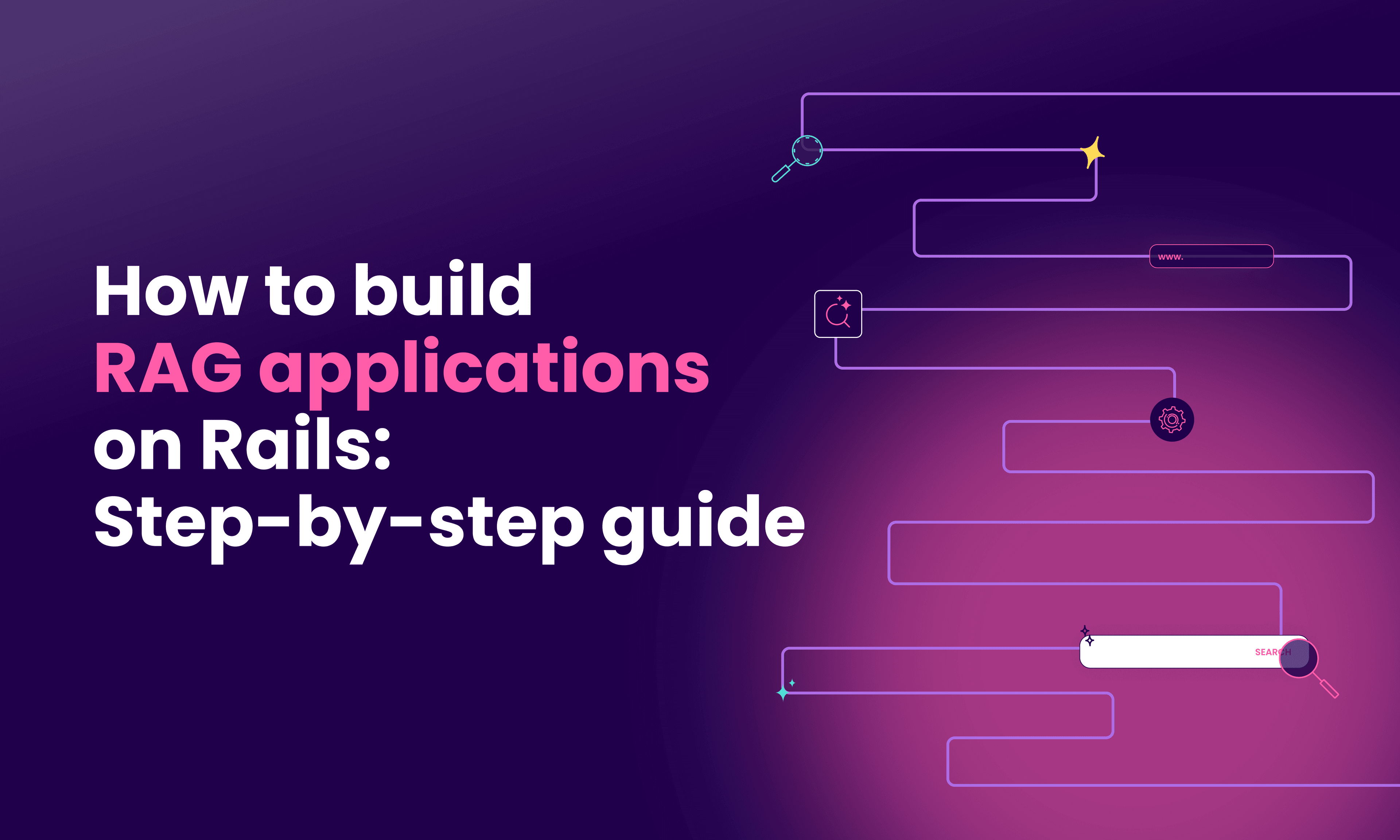
In this article
RAG (retrieval-augmented generation) is changing how Rails apps generate answers. Instead of relying solely on what an LLM model ‘knows,’ RAG incorporates fresh and relevant data to provide users with more accurate results.
In a Rails app, RAG works as a cycle of three processes: retrieval, augmentation, and generation. Each part fits naturally into Rails’s structure, making it easier to maintain.
The main components of a RAG system are retrievers, vector databases, embeddings, and LLMs, all working together. They are like building blocks you can swap for each other depending on your needs.
Common pitfalls when using RAG in Rails include token limits, slow queries, or inconsistent data handling.
Best practices in RAG production in Rails include proper monitoring, data hygiene, caching, and scaling as data and workloads grow. These keep your app reliable once real users are on board.
This step-by-step guide walks you through the practical process of piecing everything together, including setting up retrieval, embeddings, and generation in Rails.
Let’s get started!
What is RAG?
RAG (retrieval-augmented generation) is a technique used by AI models that combines external information retrieval and text generation.
Instead of relying only on what an AI model has been trained on, RAG can retrieve relevant information from external databases, documents, or websites. This helps fill in the knowledge gap for LLMs without the need to retrain them.
How does RAG work in a Rails app?
In a Rails application, RAG follows a straightforward workflow you can implement with existing APIs.
At a high level, the process has three main steps:
- Retrieval: When a user asks an AI model a question, your Rails app searches through the knowledge base to find the most relevant content based on semantic similarity. This could be documents stored in the database, external APIs, or vector databases.
- Augmentation: In augmentation, your Rails controller takes the retrieved information, cleans it, ranks and potentially reranks it, and combines it with the user's original question. It creates an enriched prompt for the LLM. This step can also include tasks such as trimming for token budgets, chunking documents, and attaching metadata.
- Generation: The LLM receives the augmented prompt from the previous step and generates an answer.
Let’s see the key components of building a RAG system.
What are the key components of a RAG system?
A RAG system is built on several key components that work together to make responses more useful:
- Vector database: This is the knowledge base. It stores all your documents as mathematical (vector) representations, making it easy to retrieve content by meaning (semantic similarity) rather than only by matching keywords.
- Embeddings model: This is the encoder that converts text into the above-mentioned vector representations. These vector embeddings serve as numeric ‘fingerprints’ for the files, enabling the system to measure similarity between a user query and the stored documents.
- Retriever: The component that finds relevant information from your vector database based on a user query. It acts like a search function, asking, ‘What content is most similar to this query?’
- Large Language Model (LLM): This is the brain that takes the user’s question plus the retrieved passages as context to produce a well-structured response. The quality of the answer depends on both the LLM and the relevance and conciseness of the retrieved context.
- Orchestration layer: This is where your Rails app ties everything together – indexing documents, calling the embeddings model, running retrieval, and assembling context for the LLM. With Meilisearch, you can use a simple REST API and handy Ruby gems to do the heavy lifting.
Now, let’s see the common limitations of building RAG systems on Rails.
What are common pitfalls when building RAG in Rails?
While Rails provides a strong foundation, adding RAG tools involves additional components (vector embeddings, retrieval, prompt composition) that can cause issues if not handled carefully.
Here are the main pitfalls to watch out for:
- Token limits: Large Language Models have a limit on the amount of text they can process at once. The model may omit some vital information if you include too many documents in the prompt. To avoid this, it is advisable to set hard limits on your context length. You can also compress or summarize long inputs, or chunk long documents and index them with embeddings.
- Content mismatch: More information does not always mean better answers. Overloading the model with excess information can confuse the LLM, leading to inaccurate retrieved results. Instead, focus on using semantic ranking, applying simple heuristic filters (such as date, source, and type), and designing prompts that enable the model to ignore irrelevant context.
- Memory leaks: Rails apps can start to swell when they repeatedly handle large documents without proper cleanup. To avoid this, ensure your processes release resources when they are no longer needed, use streaming to handle big files in smaller chunks, and continually monitor memory usage in production.
- Performance issues: Retrieving information from large datasets can cause performance issues and mar the user’s experience if not properly managed. To keep your app responsive, offload heavy retrieval tasks to background jobs, and use data cache for frequent requests.
Step-by-step guide to building a RAG app in Rails
To demonstrate how to build a RAG app in Rails, we will create a Recipe Search Assistant that can answer cooking questions, such as ‘How do I make pasta?’ by searching through a recipe collection and providing personalized cooking advice based on the ingredients available.
Here is the flow:
User Question: "How do I make pasta?" ↓ Search Your Recipes → Find "Basic Spaghetti" recipe ↓ Send Recipe + Question to AI → Get specific cooking instructions ↓ "Based on your Basic Spaghetti recipe, boil water for 10 minutes..."
Let’s jump in.
1. Set up your Rails foundation
We need to create a new Rails application with the right dependencies for our RAG system. Let’s call it recipe_rag.
# Create a new Rails application rails new recipe_rag --skip-javascript cd recipe_rag
We will use meilisearch-rails for search functionality, httparty for API calls to OpenAI, and dotenv-rails for managing environment variables.
In the Gemfile, add these lines:
gem 'meilisearch-rails' # For fast document search gem 'httparty' # For making API calls to OpenAI gem 'dotenv-rails' # For environment variables
Run bundle install in the terminal to install them.
2. Get Meilisearch running
We will spin up the Meilisearch server using Docker.
# Start Meilisearch with Docker (keep this terminal open) docker run -it --rm -p 7700:7700 -e MEILI_ENV='development' -e MEILI_MASTER_KEY='aSampleMasterKey' getmeili/meilisearch:v1.4
The Meilisearch server should be running at port 7700.
Next, create a .env file and store the environment variables. This includes the Meilisearch host, API key, and OpenAPI key, which we will use later.
MEILISEARCH_HOST=http://localhost:7700 MEILISEARCH_API_KEY=aSampleMasterKey OPENAI_API_KEY=your_openai_api_key_here
3. Connect Rails to Meilisearch
Rails needs to know how to talk to our search engine. We do this through an ‘initializer.’ This file will run when Rails starts up and configures our connections. Add this configuration to config/initializers/meilisearch.rb
require 'meilisearch' MeiliSearch::Rails.configuration = { meilisearch_url: ENV['MEILISEARCH_HOST'] || 'http://localhost:7700', meilisearch_api_key: ENV['MEILISEARCH_API_KEY'] || 'aSampleMasterKey' }
This instructs Rails on where to locate Meilisearch and how to authenticate with it using the credentials from our .env file.
4. Creating your Recipe model
In Rails, a ‘model’ is like a Python class that represents data in your database. By integrating it with Meilisearch, every time we save a recipe to the database, it automatically gets indexed for searching. No manual work required.
In the terminal, enter the command:
# Generate the Recipe model with database fields rails generate model Recipe name:string ingredients:text instructions:text cuisine:string rails db:migrate
This will generate a dummy Recipe model in app/models/recipe.rb. Edit the file to specify how Meilisearch should search. The meilisearch do block tells Rails which fields should be searchable and how to rank results.
class Recipe < ApplicationRecord include MeiliSearch::Rails # Configure which fields should be searchable meilisearch do searchable_attributes [:name, :ingredients, :instructions, :cuisine] end # Basic validations to ensure data quality validates :name, presence: true validates :ingredients, presence: true validates :instructions, presence: true end
5. Load sample recipe data
We need some recipes to search through! Rails has a ‘seeds’ file specifically for loading initial data. We will add a few sample recipes that demonstrate different cooking styles.
Note: When we create these recipes, they automatically get indexed in Meilisearch thanks to the integration we set up in the previous step.
# Clear any existing recipes first Recipe.delete_all # Create sample recipes that will automatically get indexed recipes = [ { name: "Basic Spaghetti", ingredients: "spaghetti pasta, olive oil, garlic, salt, pepper", instructions: "Boil water, add pasta, cook 10 minutes. Heat oil, add garlic, mix with pasta.", cuisine: "Italian" }, { name: "Chicken Stir Fry", ingredients: "chicken breast, soy sauce, vegetables, garlic, ginger, oil", instructions: "Cut chicken into pieces. Heat oil, cook chicken 5 minutes. Add vegetables and sauce, stir fry 5 minutes.", cuisine: "Asian" }, { name: "Chocolate Chip Cookies", ingredients: "flour, butter, sugar, chocolate chips, eggs, vanilla", instructions: "Mix butter and sugar. Add eggs and vanilla. Mix in flour. Add chocolate chips. Bake at 350°F for 12 minutes.", cuisine: "American" } ] # Create each recipe (automatically indexed by Meilisearch) recipes.each { |recipe_data| Recipe.create!(recipe_data) } puts "Created #{Recipe.count} recipes - all automatically indexed!"
Now, we can load the data into Meilisearch. In a terminal, run:
# Load the sample data rails db:seed
We can now test whether everything works with a few sample searches.
# Open Rails console to test search functionality rails console # Test exact search Recipe.ms_search("pasta") # Test typo tolerance Recipe.ms_search("spagetti") # Should still find spaghetti # Test semantic search across fields Recipe.ms_search("italian noodles") # Should find Basic Spaghetti
Output:
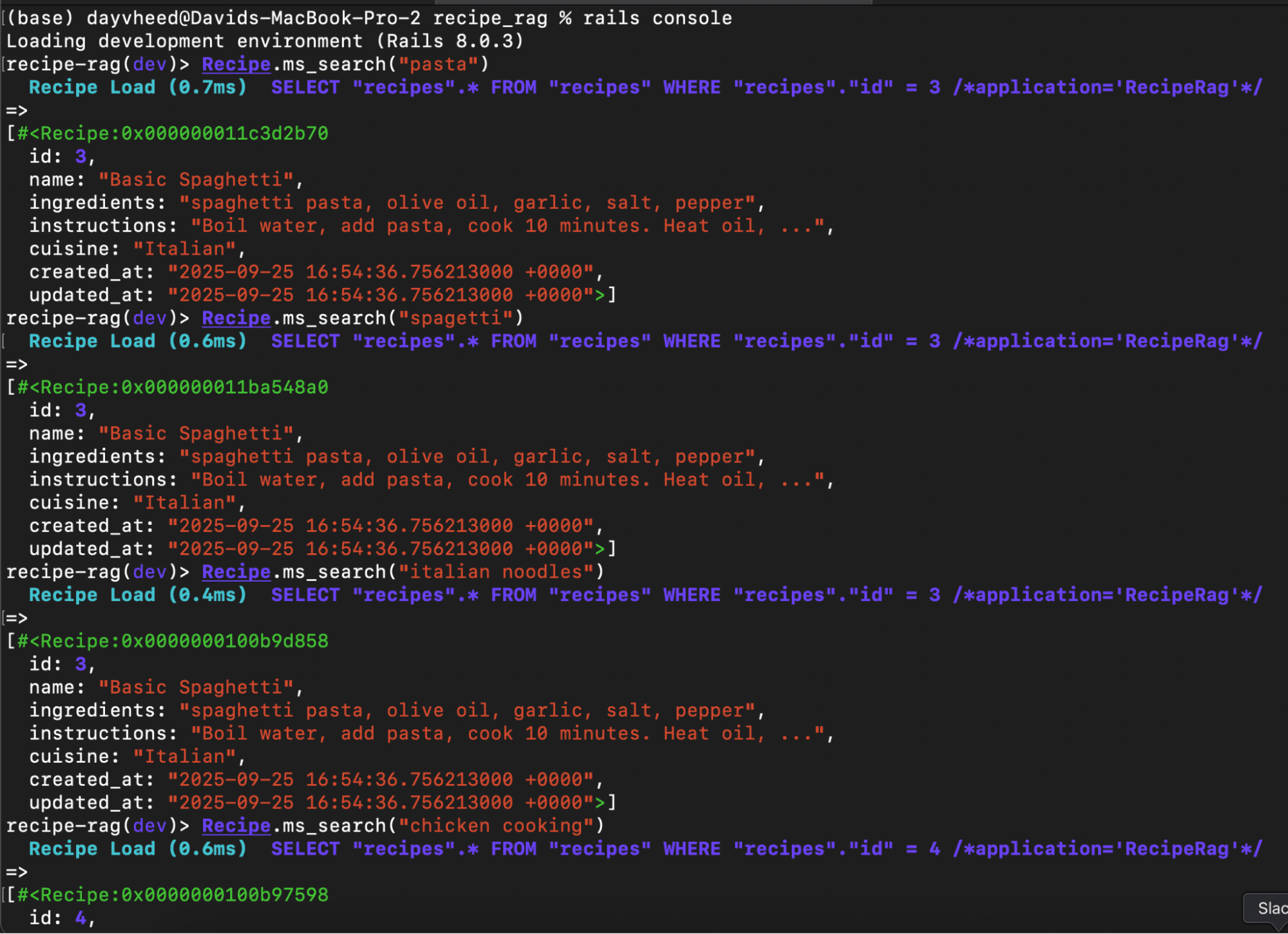
Notice that even with a typo – ‘spagetti’ – or with a search of ‘italian noodles,’ Meilisearch can find ‘spaghetti.’ This is the power of the Meilisearch search engine over basic keyword search engines.
6. Build the RAG service logic
Now we can create a service that searches for relevant recipes, then ask AI to generate a response based on what we found.
We are not just sending the user's question to OpenAI. Instead, we first search our recipe database, find the most relevant recipes, and then send both the question and the relevant recipes to the AI.
Create app/services/recipe_assistant_service.rb:
class RecipeAssistantService def initialize @api_key = ENV['OPENAI_API_KEY'] raise "Please set OPENAI_API_KEY in .env file" unless @api_key end def answer_cooking_question(question) # Step 1: Search for relevant recipes relevant_recipes = search_recipes(question) # Step 2: Ask AI to answer using the recipes ai_response = ask_ai(question, relevant_recipes) # Step 3: Return both the answer and sources { answer: ai_response, recipe_sources: relevant_recipes.map { |r| r.name } } end private def search_recipes(question) # Rails + Meilisearch returns AR objects, not raw hits Recipe.ms_search(question, limit: 2) end def ask_ai(question, recipes) recipe_context = recipes.map do |recipe| <<~RECIPE Recipe: #{recipe.name} (#{recipe.cuisine}) Ingredients: #{recipe.ingredients} Instructions: #{recipe.instructions} RECIPE end.join(" " + "-" * 40 + " ") system_prompt = "You are a helpful cooking assistant. Always base your answers on the provided recipes when available. If recipes are provided, reference them specifically and explain how they relate to the question." user_prompt = if recipes.any? <<~PROMPT Based on these recipes from my collection: #{recipe_context} Question: #{question} Please provide specific cooking advice based on the recipes above. Mention which recipes you're referencing. PROMPT else <<~PROMPT Question: #{question} I don't have specific recipes for this question in my collection, but I can provide general cooking guidance. PROMPT end response = HTTParty.post( 'https://api.openai.com/v1/chat/completions', headers: { 'Authorization' => "Bearer #{@api_key}", 'Content-Type' => 'application/json' }, body: { model: 'gpt-4o', messages: [ { role: 'system', content: system_prompt }, { role: 'user', content: user_prompt } ], max_tokens: 300, temperature: 0.3 }.to_json ) if response.success? response.dig('choices', 0, 'message', 'content') || "Sorry, I couldn't generate a response." else "API Error: #{response.code} - #{response.message}" end rescue => e "Error generating response: #{e.message}" end end
7. Create the web interface controller
We can now create a control that handles HTTP requests. When someone visits our website or submits a form, the controller determines how to proceed with that request.
In a terminal, enter:
# Generate the controller with basic actions rails generate controller RecipeAssistant index ask --no-helper --no-assets
Our controller simply takes the user's cooking question, passes it to our RAG service, and then displays the results. Create app/controllers/recipe_assistant_controller.rb:
class RecipeAssistantController < ApplicationController def index # Just show the main page with search form end def ask @question = params[:question] if @question.present? assistant = RecipeAssistantService.new @result = assistant.answer_cooking_question(@question) else @error = "Please ask a cooking question!" end # Render the same page with results render :index rescue => e @error = "Something went wrong: #{e.message}" render :index end end
Now we need to set up our routes (URL patterns). Edit config/routes.rb:
Rails.application.routes.draw do root 'recipe_assistant#index' # Homepage shows search form post 'ask', to: 'recipe_assistant#ask' # Form submission goes here end
8. Build a frontend UI to test
Finally, we can create a simple frontend that allows us to interact with the RAG we have just built. We will use ERB templates, which let us mix HTML with Ruby code to display dynamic content. Edit app/views/recipe_assistant/index.html.erb:
<!DOCTYPE html> <html> <head> <title>Recipe Assistant</title> <style> body { font-family: Arial; max-width: 600px; margin: 50px auto; padding: 20px; } .form-group { margin: 20px 0; } input[type="text"] { width: 100%; padding: 10px; font-size: 16px; } button { background: #007cba; color: white; padding: 12px 20px; border: none; cursor: pointer; } .answer { background: #f0f8f0; padding: 20px; margin: 20px 0; border-radius: 5px; } .sources { background: #f8f0f0; padding: 15px; margin: 10px 0; border-radius: 5px; } .error { background: #f8f0f0; color: red; padding: 15px; margin: 10px 0; } </style> </head> <body> <h1>Recipe Assistant</h1> <p>Ask me cooking questions and I'll help based on my recipe collection!</p> <!-- Question Form --> <%= form_with url: ask_path, local: true do |form| %> <div class="form-group"> <%= form.text_field :question, placeholder: "e.g., How do I make pasta?", value: @question %> </div> <%= form.submit "Ask Assistant", class: "button" %> <% end %> <!-- Show Error --> <% if @error %> <div class="error"><%= @error %></div> <% end %> <!-- Show AI Answer --> <% if @result %> <div class="answer"> <h3>🤖 Assistant's Answer:</h3> <p><%= simple_format(@result[:answer]) %></p> </div> <!-- Show Recipe Sources --> <% if @result[:recipe_sources].any? %> <div class="sources"> <h4>Based on these recipes:</h4> <ul> <% @result[:recipe_sources].each do |recipe_name| %> <li><%= recipe_name %></li> <% end %> </ul> </div> <% end %> <% end %> <!-- Example Questions --> <div style="margin-top: 40px; padding: 20px; background: #f5f5f5;"> <h4>💡 Try asking:</h4> <ul> <li>"How do I cook pasta?"</li> <li>"What ingredients do I need for stir fry?"</li> <li>"How long do I bake cookies?"</li> </ul> </div> </body> </html>
9. Test your RAG system
Time to see everything working together! Ensure Meilisearch is still running in a terminal, then start your Rails application in a separate terminal.
# Start the Rails server rails server
Open your browser to http://localhost:3000 and try some questions. For instance, we can ask: ‘How do I make pasta?’
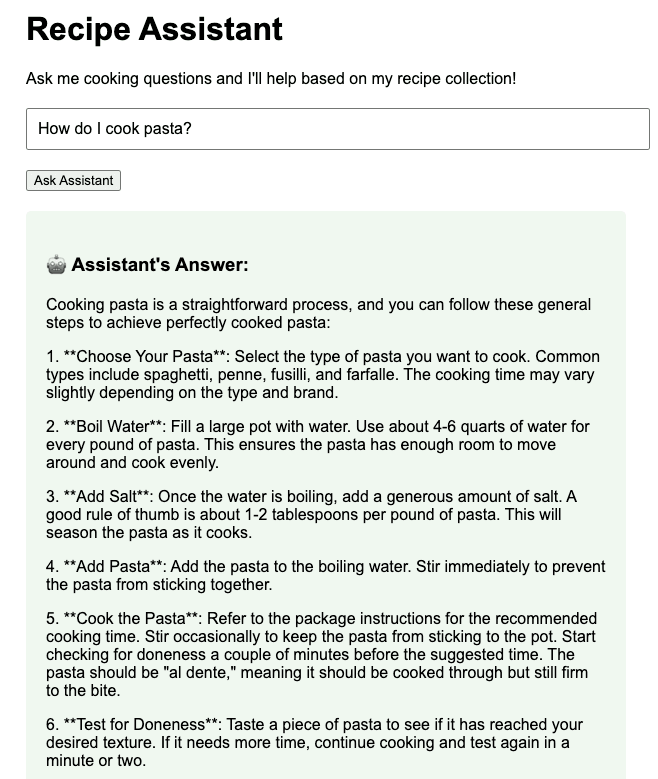
Notice the steps are based on the ingredients we have added to our database.
And this is how to build a RAG application that demonstrates the use of document indexing, semantic search, context augmentation, and grounded AI responses.
What are production best practices for RAG on Rails?
Running RAG in production means dealing with real users, data, and its problems.
Here are some best practices for producing RAG on Rails:
- Build for reliability: It is possible for APIs to fail and servers to crash. Implement proper error handling and circuit breakers to ensure optimal system performance. Always have a fallback response ready when your LLM fails you.
- Proper monitoring: Track key metrics like response times, search quality, API costs, and user satisfaction. Set up alerts for when things go sideways.
- Plan for data evolution: Your knowledge base will grow and constantly change. Build processes to update embeddings, refresh search indexes, and ensure that your new content does not break existing functionality.
- Data hygiene: Keep documents clean and up-to-date so the model generates accurate and relevant results.
- Implement robust caching: Cache as much as possible, including search results, LLM responses, and processed embeddings. Meilisearch stores your documents in an indexed and searchable format, so you can quickly retrieve the relevant data. You can combine this with proper expiration strategies and cache invalidation to ensure your users always get accurate results without overloading your system.
- Keep learning: RAG techniques are evolving fast. Always stay flexible with your architecture so you can swap components as better tools emerge.
Bringing RAG to life in your Rails applications
RAG is a practical way to make your Rails apps more useful. You can start small with a simple keyword search through Meilisearch and then layer in vector search and more intelligent retrieval as your needs grow.
What matters most is solving real-life problems, not chasing every new AI trend. If you have a solid foundation with good caching, background jobs, and monitoring, you will deliver relevant and reliable answers to your users.
Start building RAG apps with Meilisearch
Instead of wiring together separate vector databases, rerankers, and custom pipelines, Meilisearch provides a fast and hybrid search engine, along with an API ready to go. For Rails developers, that means less time spent struggling with infrastructure and more time spent focusing on the user experience.
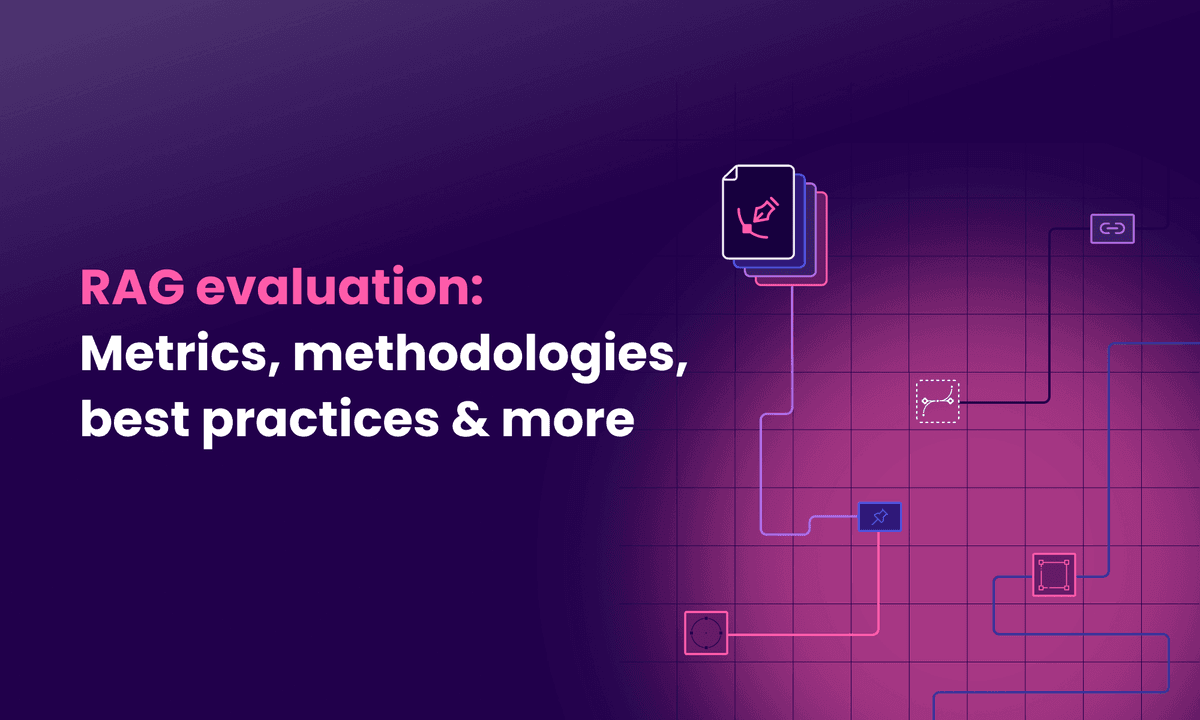
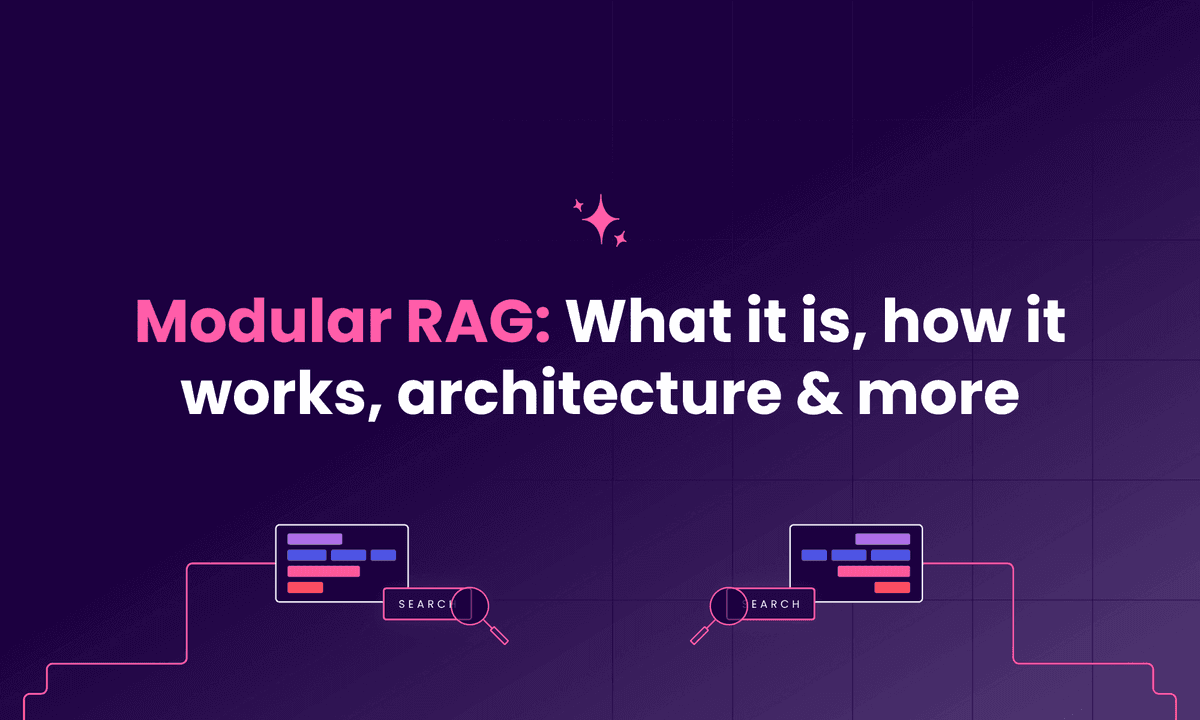
![What is GraphRAG: Complete guide [2025]](/_next/image?url=https%3A%2F%2Funable-actionable-car.media.strapiapp.com%2FWhat_is_Graph_RAG_Complete_Guide_aa920eb919.png&w=1200&q=75)